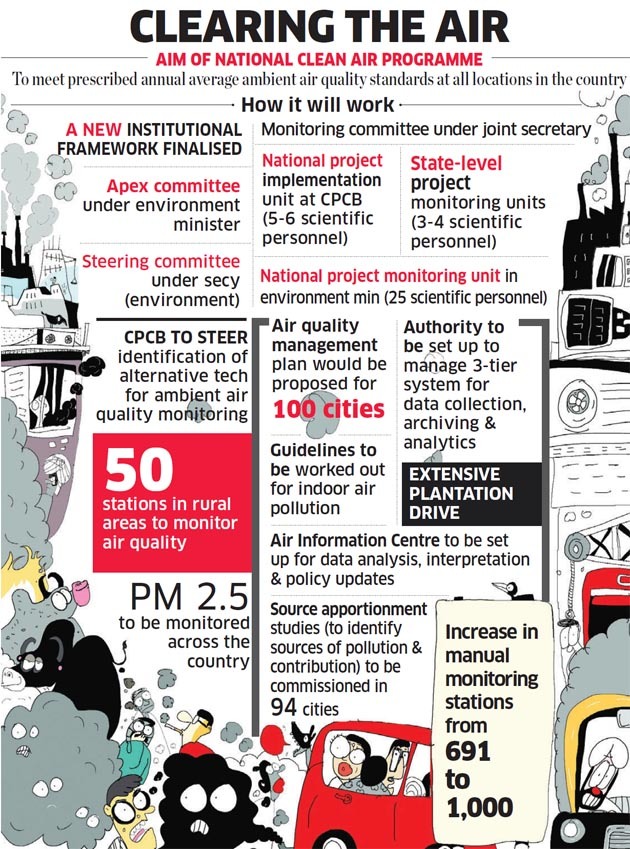- Home
- Prelims
- Mains
- Current Affairs
- Study Materials
- Test Series
National Clean Air Programme: Centre aims at 40% reduction in particulate matter by 2026
The Centre has revised the target to reduce air pollution (PM concentrations) in cities from 20-30% by 2024 to 40% by 2025–26, encouraged by the performance of 95 cities that demonstrated improvement in air quality in 2021–22 as compared to 2017 levels.
The updated goal might encourage the respective states to increase their ambition through city-based action plans for the National Clean Air Program (NCAP).
- Twenty cities under NCAP, including Chennai, Madurai, Nashik, and Chittur, have even met the National Ambient Air Quality Standards (NAAQS), which set an annual average limit of PM10 at 60 ug/m3. This information comes from a recent MoEFCC analysis of cities under NCAP.
- The more hazardous PM2.5, however, was not discussed in the analysis because not all NCAP cities monitor it. Under NAAQS, the annual average PM2.5 prescribed standard is 40 ug/m3.
- However, many cities are anticipated to achieve significantly greater reductions, with Varanasi recording the highest 53% reduction in PM10 levels in 2021–2022 (over 2017 levels).
NCAP

- The MoEFCC introduced it in January 2019. It will be a mid-term, five-year action plan.
- It is the first time a national framework for air quality management has been created in the nation with a deadline for reduction.
- Goal: The objective of NCAP is to achieve the required annual average ambient air quality standards across the nation within a predetermined time frame. The NCAP proposes a tentative national level target of a 20%–30% reduction in PM2.5 and PM10 concentration by 2024, using 2017 as the base year for concentration comparisons.
- Objective:
- 131 cities are being targeted by NCAP for air quality improvement. Out of these 131 cities, 123 cities (NACs) are recognised by NCAP as not meeting national ambient air quality standards (NAAQS) five years in a row.
- Additionally, the 15th Finance Commission''s (XV-FC) list of million plus cities (MPCs) that are eligible to receive performance-based grants for the improvement of air quality also includes MPCs.
Initiatives under NCAP:
- Indoor Air Pollution Monitoring & Management: It describes the physical, chemical, and biological properties of indoor air in a house, building, institution, or commercial establishment. It would include setting up an Air Information Centre, Certification system for monitoring instruments, Air Quality Forecasting System, Extensive Plantation Drive, Intensive Awareness, Training and Capacity Building Drive etc. It will also have a three tier mechanism for review of monitoring, assessment and inspection for implementation
- Air Quality Management Plan for 100 Non-Attainment Cities: The city action plans need to be based on a thorough scientific approach that includes (i) identifying emission sources, (ii) determining the extent of these sources'' contributions, (iii) prioritising the sources that need to be addressed, (iv) assessing the feasibility and economic viability of various options for controlling the sources, and (v) formulating action plans.
- National Emission Inventory: An accounting of the quantity of pollutants released into the atmosphere is called an emission inventory.
- Network of Technical Institutions: For the establishment and administration of Government of India policies and programmes on air pollution, a Knowledge Partners Network of highly skilled and experienced academicians, academic administrators, and technical institutions will be established.
- Technology Assessment Cell: Technology Evaluation Cell is intended to assess technologies important in relation to pollution prevention, control, and abatement. The cell is anticipated to concentrate on both domestic and foreign monitoring and mitigation technologies.
NGT on NCAP:
- The Ministry of Environment, Forests and Climate Change (MoEFCC) was previously ordered by the National Green Tribunal (NGT) to make changes to the National Clean Air Programme (NCAP). By 2024, NCAP suggests a 20–30% reduction in air pollution.
|
Source allocation is the process of determining which sources of pollution are responsible for a given amount of ambient air pollution. The term "carrying capacity" refers to the maximum number of people that can enter a given space without endangering its environmental quality. |
- NGT issued the following directives:
- The 2024 deadline to reduce air pollution by 20–30% must be lowered.
- Increase the reduction target.
- Review the actions taken, such as the switch to CNG and electric vehicles, the expansion of public transportation, the mechanical sweeping of roads, the improvement of fuel quality, etc.
- Within six months, make sure the necessary number of ambient air quality monitoring systems has been assessed and installed.
- Additionally, it instructed the Central Pollution Control Board''s expert team to create within two months a model for source allocation and carrying capacity assessment that could be used for all non-attainment cities.









 Latest News
Latest News
 General Studies
General Studies